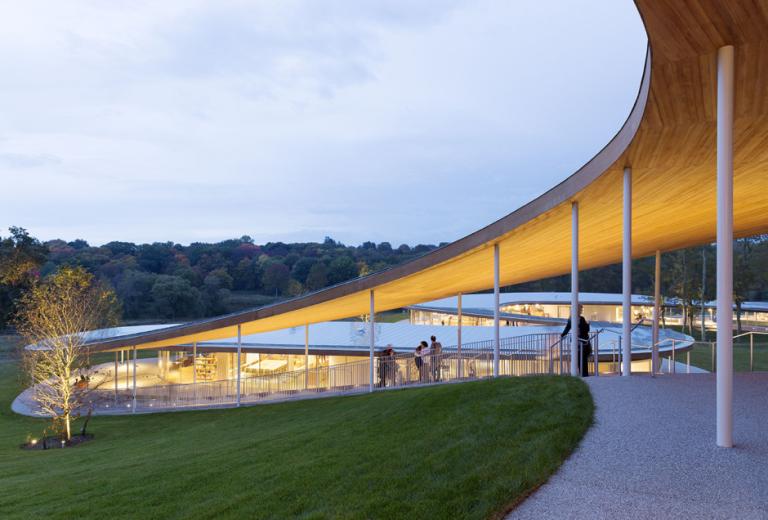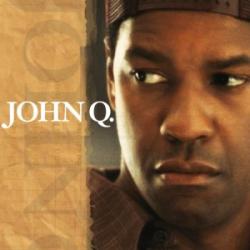Martin Filler writes about architecture for The New York Review of Books. He’s awed by the ambition, beauty, and seamless elegance of Grace Farms, a former Connecticut horse farm transformed into “an exquisitely realized exercise in integrated architectural and landscape design.”

I’ll defer to Filler’s expertise and confirm that, to my unschooled eye, the place sure looks pretty. Click through to his review — “Faith in Good Taste” — and look at the gorgeous accompanying photos I’m sure you’ll agree.
Set amid a verdant, gently rolling eighty-acre former horse farm, Grace Farms is described on its website as “a welcoming new place … for people to experience nature, encounter the arts, pursue justice, foster community, and explore faith.” That is quite an idealistic agenda, and only the most cynical are likely to see this impressive undertaking as anything but a potential boon to contemporary society.
But I also have to agree with Filler’s sneaking suspicion throughout this review that maybe those hypothetical “most cynical” folks might have a point. Thus, in describing the purpose and function of this place, Filler resorts to a quote from a master of cynicism, saying this is a place where “human kindness is overflowing.”
Filler’s ambivalence comes, I think, from his architect’s eye for the marriage of beauty and utility, of form and function. And it’s tricky to decide whether this impeccably designed and executed facility is ideally suited for its function, because it’s difficult to say, precisely, what that function is supposed to be.
It has something to do with a church — “the nondenominational Grace Community Church,” and yet:
The connection between the two organizations is left vague by their adherents, who insist that Grace Farms is not a church. In keeping with this broader mission, the complex includes a library (which focuses on five themes — “Faith + Meaning,” “Art + Beauty,” “Justice + Ethics,” “Nature + Environment,” and “Community + Relationships”), a restaurant, tearoom, offices, and sunken indoor basketball court; there are also classrooms, meeting spaces, performance and art studios, and more offices in two nearby converted stables.
On one level, that all sounds wonderful. “Faith + Meaning”? Yes, please. “Art + Beauty”? I’m all for it. “Justice + Ethics”? A bit redundant, perhaps, but absolutely, yes. “Nature + Environment” and “Community + Relationships”? Awesome.
So why, like Filler, am I inclined to bristle with a Newmanesque skepticism at all this earnest beauty?
I think it’s not so much the question of “what is this place for?” as the question of “who is this place for?” We don’t see any people in all those gorgeous photographs of this dazzling place. And it’s hard to imagine populating those photos with anyone other than the populace of “the so-called Gold Coast of Fairfield County, which includes New Canaan, ranks sixth in the US in per-capita income and presumably is not in dire need of more libraries, sports facilities, or parkland.”
 Attempt to populate those photographs in your mind’s eye and you’ll either be forced to confront questions of race and class, or else you’ll settle those questions, conclusively, by not doing so.
Attempt to populate those photographs in your mind’s eye and you’ll either be forced to confront questions of race and class, or else you’ll settle those questions, conclusively, by not doing so.
Perhaps that’s what separates the extravagant beauty of this place from the extravagant beauty of a cathedral, where the vast expense of such beauty is (in theory, at least) devoted ad majorem Dei gloriam, and the doors are open to all people (again, at least in theory).
Grace Farms is a beautiful property, but that beauty is someone’s property. It is owned by them because, after all, they paid for it.
And if they can own Art+Beauty and Nature+Environment, perhaps they can also now own the properties of Justice+Ethics, of Faith+Meaning, and of Community+Relationship.
Years ago I talked to Gene Rivers, a formidable black Pentecostal preacher/activist, after he spent a few days at the Aspen Institute. He said the experience was “terrifying.” Here was this gathering of brilliant elite progressive types laying out their utopian vision of the future and, in their imagined utopian future, black people did not seem to exist at all. They didn’t explain how they would “get rid of us,” Gene said, but that seemed to be an unspoken part of the master plan.
Grace Farms reminds me of that conversation because it provides another picture of a vaguely “progressive” utopia that, at the same time, seems to have gotten rid of the kinds of people who couldn’t afford to be there.
When I try to correct for that, try to imagine a more diverse crowd of people in these beautiful photographs of this beautiful place, I wind up picturing those people in the uniforms of Starfleet Academy cadets. It’s easier for me to people those pictures by imagining the utopian future of Star Trek — a world in which class has been, somehow, transcended — than it is by imagining the prospects of the church in Fairfield County.
Maybe that’s because I’ve spent too much time watching television. Or maybe that’s because I’ve spent too much time in American churches.
Here’s Martin Filler’s conclusion:
The extent to which religion gives shape to Grace Farms’ overall ethos may or may not be of overriding significance. But for all the thoughtfulness that has gone into its creation, one wonders … whether the expenditure of such immense sums, in the midst of almost unimaginably concentrated wealth, is the true path to a state of grace for those who would alleviate the sufferings of humankind.












